Phylum Arthropoda
The Arthropods
Disclaimer:
Let if be said at the outset
that there is no way we can possibly even come close in one week to doing
justice to this incredibly diverse and important phylum. Though it might
seem we cover a lot, all we will do is scratch the surface of arthropod
diversity.
Actually, we won't even
do that.....
....we'll just START to
scratch the surface.
You may think in the end that
you have learned a lot of arthropod diversity, but you will only have the
faintest idea of how weird and wonderful and diverse the arthropods truly
are!
OK then, lets get on with it......
1. Arthropods - the most diverse animal
phylum.....
See
http://www.explore.cornell.edu/scene.cfm?scene=Beetle%20Science
2. Defining features of arthropods:
Segmented bodies
Jointed appendages
Have exoskeletons
Hard armor-like covering on outside of body
Made of chitin (a type of carbohydrate), hardened with
proteins
Must be shed periodically to allow for growth
exoskeleton is soft immediately after a molt
"soft-shell crab" in restaurants- recently
molted crabs
animal more vulnerable to predators for awhile after
molting
female crustaceans can only mate when in
this softened state (this is not the case for other female arthropods
such as insects though)
Muscles attach to the interior of exoskeletons - see diagram
of crustacean musculature: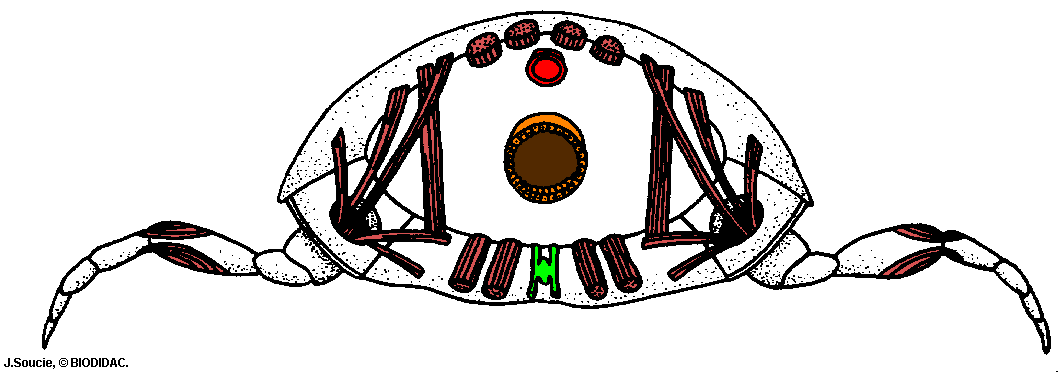 Exoskeleton extends internally (e.g. lining parts of gut)
internal parts shed as well
Well-developed nervous systems with ventral nerve cords
Open circulatory systems
No cilia!
Overall, very complex body structures - as complex (or more complex) than comparably-sized vertebrates
Exoskeleton extends internally (e.g. lining parts of gut)
internal parts shed as well
Well-developed nervous systems with ventral nerve cords
Open circulatory systems
No cilia!
Overall, very complex body structures - as complex (or more complex) than comparably-sized vertebrates
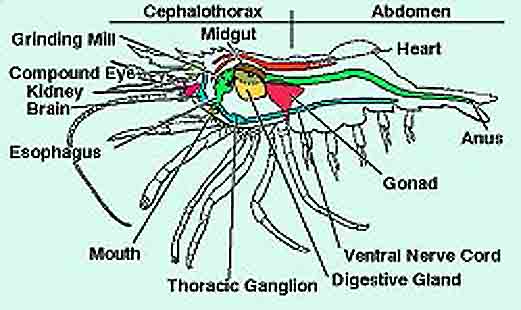
3. Probably evolved from segmented worm
ancestors similar to polychetes
First arthropods had worm-like bodies, many nearly identical
segments, legs on each segment.
Trends in arthropod evolution (modifications of basic
body ancestral body plan):
Reduction in number of segments
Grouping of segments into distinct body regions (e.g.
thorax of insect is ade up of several fused segments)
Increasing cephalization
arthropod heads consist of multiple fused segments
the numerous complex mouthparts are highly modified limbs
Specialization of legs in some segments for specific
functions, and loss of legs from some segments.
4. Some of the major arthropod groups:
Subphylum Trilobita
Subphylum Chelicerata
Subphylum Crustacea
Subphylum Urinamia
These groups are described below:
Subphylum Trilobita - the trilobites
VERY abundant and diverse in paleozoic seas
All extinct now!
Diverse lifestyles and habits (comparable range to today's
crustaceans)
Extensive fossil record
see: Introduction
to Trilobites for photos and diagrams
Trilobites must have been incredibly
cool when they were alive!
Subphylum Chelicerata - spiders and
their relatives
Usually two body segments
No antennae
Chelicerae - pincer-like or fang-like mouthparts
Cephalothorax with 5 pairs of appendages
in some groups all used for walking
in some groups first pair modified into pedipalps (used
in feeding)
Some of major classes of Chelicerata:
Class Pycnogonida- "sea spiders"
Weird marine predators (or external parasites in some
cases?)
NOT uncommon
skinny bodies, internal organs extend out into legs!
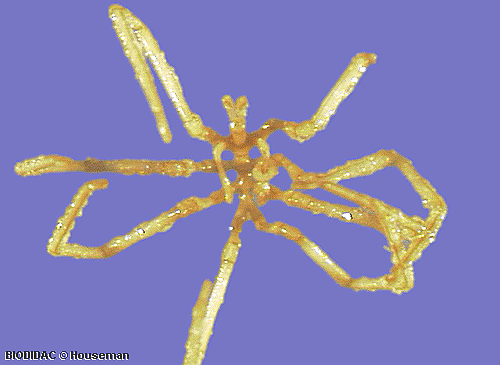
Class Merostomata - the horseshoe crabs
Not "true" crabs
See diagrams at http:anat.html,
which shows a very different body structure from crabs
Relicts of ancient group that is mostly extinct
Living species are very common animals in many
coastal marine habitats
Scavengers/predators (on sand-dwelling creatures)
Burrow in sand by day, active at night
Lay eggs in sand on beaches above water line (see photos at http:spawn.html)
mass spawnings
enormous amounts of eggs
laid in a spawning area
horseshoe crab eggs are a critical food source for migrating
shorebirds along east coast of North America (if want
more info, go to: http:eco.html...this
is NOT a required reading)
the birds can't complete migration without "tanking
up" on these eggs!
Class Arachnida - Spiders, ticks, mites,
daddy longlegs, scorpions, whipscorpions, etc.
Generally two body segments
segments fused in ticks, mites, and daddy longlegs
Generally 4 pairs of walking legs (8 legs total) plus
pair of chelicerae (fangs) and pair of pedipalps (manipulate food)
Most species terrestrial
a few freshwater exceptions: water mites, plus few species
of water spiders
Spiders
Very successful group, very
abundant
8 legs, 2 pedipalps, 2 chelicerae

Cross section of a spider. Note book lungs
in front lower part of abdomen:

Fangs (chelicerae) and pedipalps of tarantula:
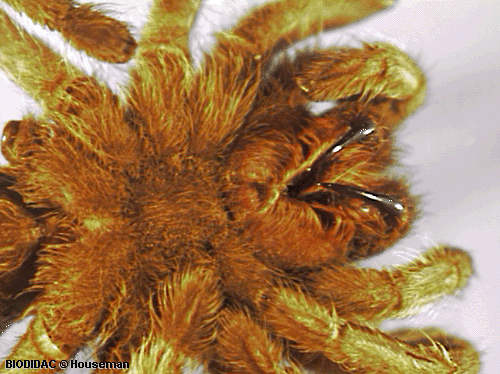
All spiders are predators
mostly predators of insects
water spiders can catch small fish!
some huge tropical terrestrial species can capture small
birds!
All make silk (made by spinnerets) - one of strongest
substances known
wrap eggs in silk
use strands as guy-lines
many species disperse by "ballooning" on strands
of silk!
many make elaborate webs to capture prey
use more than one kind of silk, sticky and non-sticky
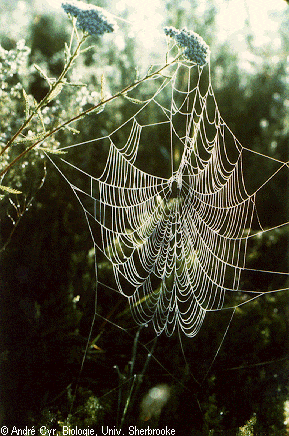
All have venom to paralyze and digest prey
some species have dangerous bites (but most do not)
Prey partially digested (liquified) before ingestion,
liquid sucked in.
Males often much smaller than females
transfer sperm to females using pedipalps
mating is risky business for males!
Mites
generally small or tiny
plant feeders, predators, etc
make silk (but not for prey capture)
Here is a photo of an unusually large and attractive
mite:

Here is another sort of mite that lives on grasshoppers
(and no, mites are not all red or orange!):

Follicle mite (lives in mammalian hair follicles):

Ticks
Suck blood
Some transmit diseases
Rocky Mountain Spotted Fever
Lyme Disease -spread by deer
ticks (more
photos)
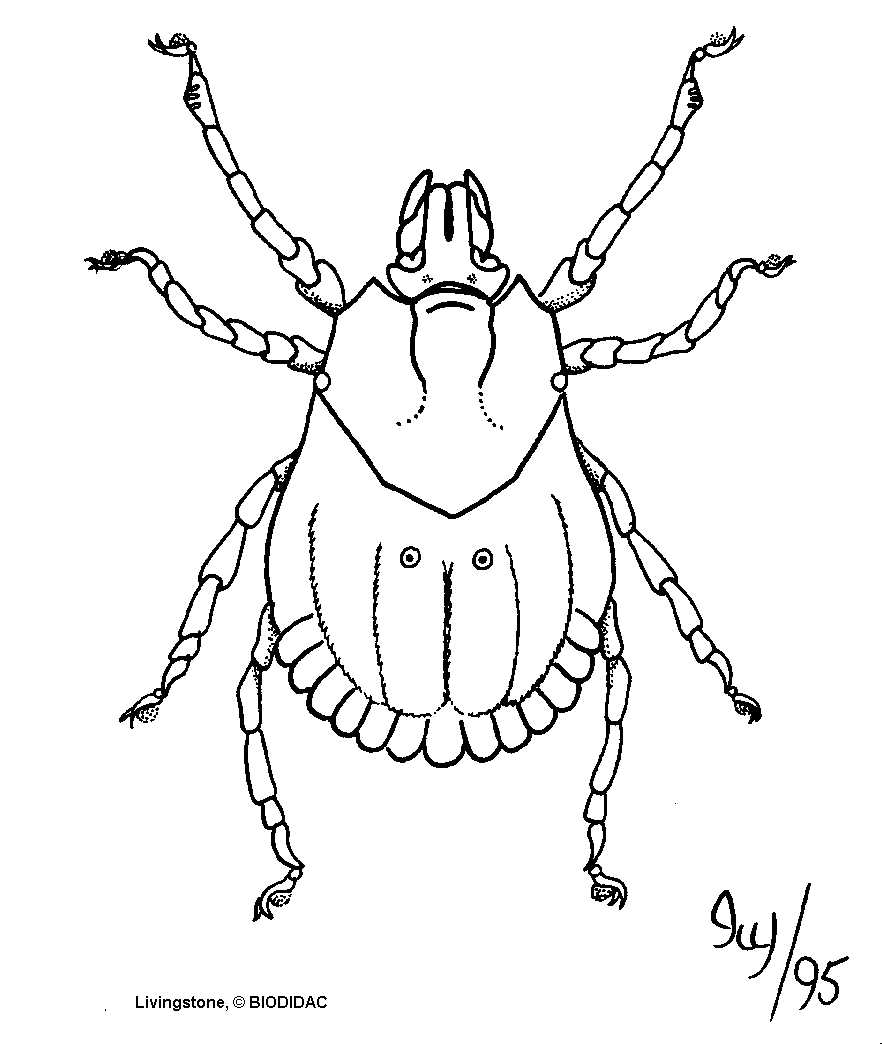
Daddy longlegs - also called harvestmen
terrestrial predators, scavengers
photos of harvestman
Arachnids, but NOT spiders
Scorpions
terrestrial predators
have set of claws
tail with venomous stinger
photos (and more info if you want to know more
- this is a completely OPTIONAL reading)
Pseudoscorpions (I'll
bet you've never heard of these!)
Tiny little terrestrial predators - even in Minnesota!
really common animals in soil, rotting leaves, tree bark,
etc.
look like scorpions without the tail
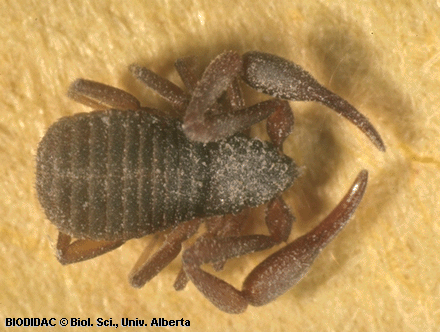
more photos of pseudoscorpions (nice photos!)
Subphylum Crustacea - the crustaceans
(crabs, shrimp, etc)
Click here for
crustacean page
Subphylum Uniramia - Centipedes, millipedes,
and insects
Click here for uniramia
page

